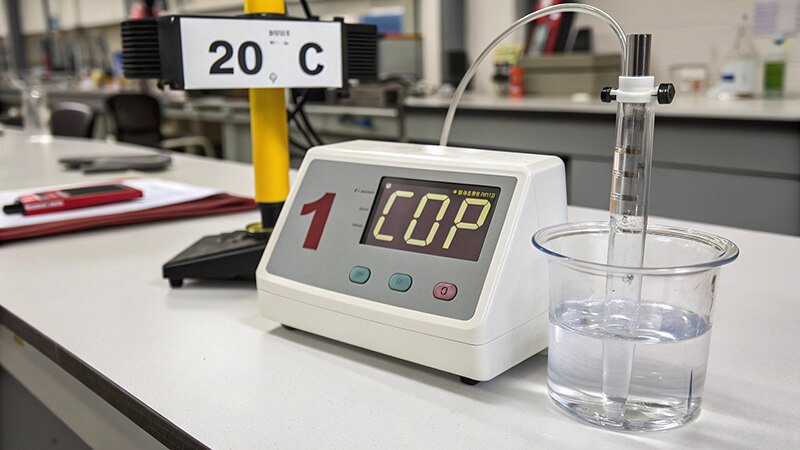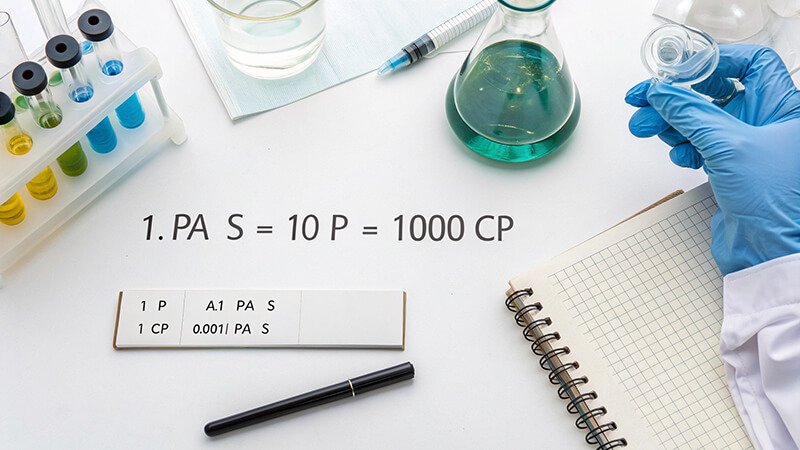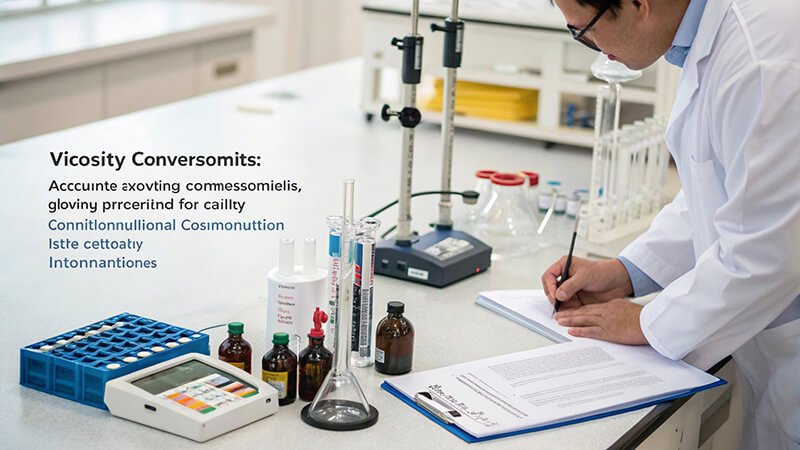Struggling to understand dynamic viscosity units? This confusion can lead to incorrect measurements and costly errors in product specifications. Learn the standard units and how they compare.
The primary SI unit for dynamic viscosity is the Pascal-second (Pa·s). It quantifies a fluid's resistance to flow under an applied force. Other common units include Poise (P) and centipoise (cP), often used in various industries.
Understanding these units is crucial. As a manufacturer of rotational viscometers at Martests, I've seen firsthand how misinterpreting units can affect quality control and international trade. Let's explore these units in more detail to ensure you're always on the same page.
What is the Standard SI Unit for Dynamic Viscosity and How is it Defined?
Unsure about the official standard for dynamic viscosity units? Using non-standard units can create confusion in technical datasheets and international communication. Discover the SI unit and its precise definition.
The standard SI unit for dynamic viscosity is the Pascal-second (Pa·s). It is defined as the force in Newtons required to move a one-square-meter plate at one meter per second past another plate separated by one meter of fluid.
The Pascal-second (Pa·s) is the cornerstone of dynamic viscosity measurement in the International System of Units (SI). Its definition comes directly from fundamental physical principles. Imagine two parallel plates, each with an area of one square meter. These plates are separated by a layer of fluid one meter thick. If you apply a force of one Newton to the top plate to make it move at a velocity of one meter per second relative to the bottom plate, the fluid between them has a dynamic viscosity of one Pascal-second.
Breaking Down the Pascal-second (Pa·s)
- Force Component: This is measured in Newtons (N).
- Area Component: This is measured in square meters (m²).
- Velocity Component: This is measured in meters per second (m/s).
- Distance Component (fluid thickness): This is measured in meters (m).
So, the unit Pa·s can also be expressed as (N × s) / m² or N·s·m⁻². This unit is derived directly from the definition of shear stress, which is Force divided by Area, and shear rate, which is Velocity divided by Distance. At Martests, we always ensure our rotational viscometers provide readings in Pa·s or allow easy conversion. We do this because Pa·s is the globally accepted standard for scientific and engineering applications. This consistency is vital for our clients. This is especially true for those in Europe and Southeast Asia who deal with diverse international standards.
Are There Other Common Units for Dynamic Viscosity, Like Poise and Centipoise, and How Do They Relate?
Encountered terms like Poise or centipoise and felt lost? Not knowing these common units can hinder understanding of older data or industry-specific reports. Learn about Poise (P) and centipoise (cP).
Yes, Poise (P) and centipoise (cP) are widely used CGS (centimeter-gram-second) units. One Poise is equal to 0.1 Pascal-seconds (Pa·s). Centipoise, one-hundredth of a Poise, is very common because water's viscosity at 20°C is approximately 1 cP.

While the Pascal-second (Pa·s) is the SI standard, the Poise (P) and centipoise (cP) remain very popular in many industries. These units belong to the older CGS (centimeter-gram-second) system of units. The Poise is named after Jean Léonard Marie Poiseuille. He was a French physicist who studied fluid flow.
Understanding Poise and Centipoise
- Poise (P): This unit is defined as 1 dyne-second per square centimeter (dyne·s/cm²).
- Its relation to Pa·s is: 1 P = 0.1 Pa·s.
- Centipoise (cP): This unit is one-hundredth of a Poise. So, 1 cP = 0.01 P.
- Its relation to Pa·s is: 1 cP = 0.001 Pa·s. This is the same as 1 mPa·s (milliPascal-second).
The centipoise (cP) is particularly convenient. Why is it so convenient? Because the viscosity of water at room temperature, which is around 20°C or 68°F, is very close to 1 cP. This provides an easy reference point. Many of our clients, especially those who have been in the industry for a long time, like Jacky from Italy, are very familiar with cP. They often request viscometer readouts in cP for continuity with their historical data. At Martests, our rotational viscometers can display results in various units. These units include Pa·s, mPa·s, P, and cP, to cater to these preferences. This flexibility is important for our B2B wholesale model, serving distributors who then cater to diverse end-users.
How Do You Convert Between Different Dynamic Viscosity Units (e.g., Pa·s, P, cP)?
Need to convert viscosity values but unsure how? Incorrect conversions can lead to significant errors in material selection or process control. Master the simple conversion factors between key units.
Converting dynamic viscosity units is straightforward: 1 Pascal-second (Pa·s) = 10 Poise (P) = 1000 centipoise (cP). Conversely, 1 P = 0.1 Pa·s, and 1 cP = 0.001 Pa·s (or 1 mPa·s).

Being able to convert between dynamic viscosity units is essential. This is especially true when dealing with international suppliers or historical data. I've often helped clients, like purchasing managers from instrument distributors, understand these conversions. This helps them compare specifications accurately. The key relationships are quite simple once you grasp them.
Key Conversion Factors:
| From | To Pa·s (Pascal-second) | To P (Poise) | To cP (centipoise) |
|---|---|---|---|
| 1 Pa·s | 1 | 10 | 1000 |
| 1 P | 0.1 | 1 | 100 |
| 1 cP | 0.001 (or 1 mPa·s) | 0.01 | 1 |
Here’s how to think about it:
- Pa·s to Poise: Multiply the value in Pa·s by 10. For example, 2 Pa·s is equal to 20 P.
- Poise to Pa·s: Divide the value in Poise by 10, or multiply by 0.1. For example, 50 P is equal to 5 Pa·s.
- Pa·s to centipoise: Multiply the value in Pa·s by 1000. For example, 0.5 Pa·s is equal to 500 cP.
- centipoise to Pa·s: Divide the value in centipoise by 1000, or multiply by 0.001. For example, 200 cP is equal to 0.2 Pa·s.
- Poise to centipoise: Multiply the value in Poise by 100. For example, 3 P is equal to 300 cP.
- centipoise to Poise: Divide the value in centipoise by 100, or multiply by 0.01. For example, 750 cP is equal to 7.5 P.
Many of our Martests rotational viscometers have built-in conversion capabilities. This feature is highly valued by our distributors. It simplifies their work and reduces the chance of errors when quoting products or comparing specifications from different sources. For instance, a client in Southeast Asia might receive specifications in cP from an American supplier. However, they may need to report in Pa·s for local regulatory compliance.
Why is Understanding These Unit Conversions Crucial in Practice?
Think unit conversions are just academic? Misunderstanding units can lead to costly purchasing errors or miscommunication with international partners. See why practical mastery is essential.
Understanding viscosity unit conversions is vital for accurate global sourcing, comparing product specifications correctly, ensuring quality control, and communicating effectively with international suppliers and customers, preventing costly misunderstandings in trade.

In my role at Martests, I interact daily with international clients. These clients range from purchasing managers at large distributors to specialized resellers. For them, the ability to fluently discuss and convert viscosity units is not just a technical detail. It is a business necessity. In our experience working with global buyers, we’ve noticed that while many understand the importance of viscosity, there’s still confusion about its units and conversions. Clear knowledge of units helps in accurate product selection and smoother international communication.
Practical Implications of Unit Conversion Mastery:
- Accurate Product Specification: When a client like Jacky from Italy requests a rotational viscometer to measure a product with a viscosity of "500," what does that mean? Is it 500 cP, 500 P, or 500 Pa·s? The difference is huge. For example, 500 cP is like olive oil. 500 P is extremely viscous, like molasses. And 500 Pa·s is almost solid-like. Knowing the common viscosity ranges for their products, such as coatings or food items, and clarifying the unit is vital.
- Comparing Quotes: Distributors often compare viscometers or materials from different countries. One supplier might list viscosity in Pa·s. Another might list it in cP. Without correct conversion, a purchasing manager cannot make an apples-to-apples comparison. This could lead to overpaying or buying unsuitable equipment.
- International Standards Compliance: Many industries have standards, such as ISO or ASTM. These standards specify viscosity ranges in particular units. Our clients exporting to Europe or the Middle East need to ensure their products meet these standards. These are often reported in Pa·s.
- Clear Communication: When we customize viscometers with a client's logo, all technical details must be crystal clear. This includes measurement ranges and units, to avoid errors. Clear knowledge of units facilitates smoother transactions and builds trust.
A few years ago, a new distributor from South America approached us. They were confused by a competitor's datasheet that listed viscosity in Poise. Their end-customer specification, however, was in milliPascal-seconds (mPa·s). We helped them with the conversion. We explained that 1 Poise equals 100 centipoise, and since 1 cP is 1 mPa·s, 1 Poise is 100 mPa·s. This clarification showed that the competitor's product was indeed suitable. This simple act of clear communication built trust and secured their business with us. This is why we focus on clarity and support at Martests.
Conclusion
Understanding dynamic viscosity units like Pa·s, Poise, and centipoise, and their conversions, is crucial for accurate measurement, effective communication, and successful international trade in many industries.


